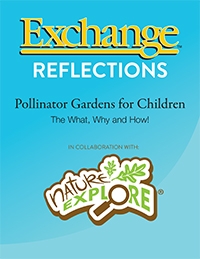ExchangeEveryDay Past Issues
 << Previous Issue
| View Past Issues | | Next Issue >>
<< Previous Issue
| View Past Issues | | Next Issue >> -Robin Moore, in Plants for Play
Landscape architect Jill Primak shared the following story in an article that forms the basis of the Exchange Reflections “Pollinator Gardens for Children: The What, Why and How!”:
My 5-year-old daughter, Anya, is the perfect conduit for me to make the leap from an adult mind and body into that of a child. In preparation for this article, she noticed me flipping through a stack of library books filled with pictures of insects and flowers. Excited to be a part of my research, we walked around the dormant pollinator garden I designed at her preschool, Dimensions, in Lincoln, Nebraska...
I asked Anya, “What is something you learned from the pollinator garden at Dimensions?”
She closed her eyes to consider her response. She knows that I am writing a very important article.
“That there is a time to take care of things, and a time to let them die,” she replied.
How can such a young human contain so much wisdom? The way she translated the cycle of the seasons in the garden into a lesson about the seasons of life demonstrates the power of gardening with children.
Primak goes on to offer several tips on creating pollinator gardens with and for children, while a post on the Natural Learning Initiative website focuses on a favorite pollinator with this important tip: “Butterflies can inspire natural learning across the curriculum of science, math, art, dramatic play, and language arts. Childcare center butterfly gardens can be created to support the complete butterfly lifecycle. To thrive, butterflies require both nectar-producing and host plants. A successful butterfly garden should contain both.” The post contains links to resources for following through.
Use coupon code NATURE for 10% off any Nature Explore Exchange Reflections |
 May not be combined with any other offer. Not valid on bulk purchase discounts. |
ExchangeEveryDay
Delivered five days a week containing news, success stories, solutions, trend reports, and much more.
What is ExchangeEveryDay?
ExchangeEveryDay is the official electronic newsletter for Exchange Press. It is delivered five days a week containing news stories, success stories, solutions, trend reports, and much more.


Post a Comment